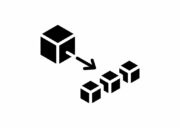
Over the last two decades, cloud computing has revolutionised the way we interact with software and digital services. But conventional cloud architecture still has limitations. It can be complex to maintain and may have geographical issues. Could the distributed cloud resolve these problems and improve the user experience?
The cloud is big business. Around 94% of all enterprises now make use of cloud services, and the trend is predicted to continue, with a forecast value of $1,241 billion for the global cloud computing market by 2027. As it has expanded to address the demands of massive AI systems and the Internet of Things (IoT), the cloud has become more complex, leading to hybrid cloud and multicloud architectures.
However, because of their geographical reach and scale, there is a range of issues unique to cloud systems. Many experts are now leaning towards distributed cloud infrastructures, which bring benefits such as improved speed, reduced inconsistencies and better compliance with legal regulations.
In this article, we’ll outline the basics of distributed cloud architecture and its uses. We’ll look at the advantages and disadvantages and ask whether the distributed cloud is the future of cloud architecture.
What is a distributed cloud and how does it work?
Put simply, ‘distributed’ means that the cloud infrastructure is spread across multiple geographical locations. Most public cloud service providers run server farms in dedicated facilities. The cloud interface that you see is mediated by sophisticated virtualisation techniques. But at base, the resources are still housed in a particular location.
Distributed cloud, on the other hand, spreads workload across servers in multiple locations, according to requirements, achieving efficiencies and performance improvements. Some key differences are:
- Geography: The distributed cloud reduces network latency. With the increasing prevalence of data-intensive AI and IoT devices, fast data transfers matter more than ever. Distributed cloud architecture can choose servers to match user locations.
- Redundancy: Provisioning services in multiple locations provides better protection against network or power outages. Of course, conventional cloud architectures build in a great deal of redundancy, but when geographical factors come into play, distribution is key.
- Compliance: Regulatory regimes are designed to ensure proper standards of security and privacy with users’ data. However, requirements differ across the globe. Distributed architectures allow data to be processed locally, maintaining legal compliance without sacrificing performance or accessibility.
Is distributed cloud architecture really new?
Of course, conventional cloud architectures already make use of geographically dispersed servers, using approaches like the hybrid cloud. So what is the difference?
Traditionally, infrastructures have been divided between on-premise services, plus private and public clouds. This so-called hybrid cloud architecture allows clients to transition between different platforms without having to abandon their legacy applications. Hybrid cloud can facilitate scaling and it is also suitable for leveraging AI technologies.
Distributed cloud dispenses with the categories of public, private and hybrid clouds. Instead, it presents a unified platform to the user. By providing a single interface, elements that would need to be managed manually in hybrid cloud setups are significantly simplified.
The mechanism for this is effectively a centralised cloud interface with geographically-spread micro-satellite services. The user administers their platform as one, but behind the scenes, the cloud provider automatically manages security, failover, regional optimisations and governance.
Use cases for a Distributed Cloud
Distributed cloud is ideal for a range of uses, particularly where scale and geo-diversity are issues.
- Content delivery: Content delivery networks play a vital role for streaming service providers like YouTube, Netflix, BBC and others. Distributed cloud services are ideal for CDNs as they can deliver content from locations closer to end users. This improves performance and responsiveness and reduces irritating buffering.
- IoT and AI: Smart devices typically rely on large volumes of data and real-time analysis. Distributed cloud provides lower latency and better bandwidth to maintain optimum performance levels.
- Scalable applications: Meeting fluctuating traffic levels and rapidly expanding service provision can be a challenge for data-reliant businesses. The distributed cloud allows dynamic expansion and automated deployment without needing extra hardware or personnel resources.
- Regulatory compliance: Regulatory frameworks like GDPR restrict what data can be stored in different locations worldwide. Distributed cloud applications allow data processing at source to ensure compliance while maintaining seamless service levels.
Advantages and disadvantages
As we have seen, distributed cloud computing offers numerous benefits over conventional infrastructures. In brief:
- Scalability: Because the distributed cloud is client-accessible from a unified interface, expanding (or contracting) service provision is easy. Scaling patterns are modular and reproducible, avoiding downtime and the complexities of hybrid solutions.
- Fault tolerance: Distributed systems are inherently more robust as location-based problems may often only affect a single node of a redundant network.
- Speed: Server location for resource-intensive transfers can be optimised by end-user location. This avoids unnecessary network hops and excess latency.
- Running costs: Distributed systems, though more expensive initially, benefit from economies of scale as well as the reduced costs of problem resolution and maintenance.
- Efficiency: By breaking down tasks into units and sending them to suitable processing locations, distributed architecture can achieve significant efficiency savings.
- Concurrency: Concurrent processing of tasks also improves performance by avoiding bottlenecks.
However, there are also some potential disadvantages, namely:
- Complexity: Because of the complex requirements during operation, they can be harder to configure and troubleshoot initially compared to centralised solutions. However, once running, operational savings should be achieved.
- Initial investment: Similarly, initial investment may be higher. The cost of the service and setup requirements usually require more upfront expenditure. But these costs should be recouped over time.
- Security: Centralised data may be easier to track than distributed. That means a whole set of security measures is required to maintain satisfactory levels over large-scale projects. These require robust policies which will scale with the infrastructure itself.
Distributed cloud and edge computing
Edge computing is a paradigm that is readily facilitated with distributed cloud infrastructures. Edge computing is a systems architecture pattern. It means bringing computation closer to the sources of data, rather than gathering all resources in a central computational location. This sensitivity to the location of data is in contrast to the centralised model of traditional computers.
Like distributed cloud more generally, edge computing is ideal for applications where big data sets, low latency and real-time processing are paramount considerations. The concept is not entirely new and dates back to the late 1990s when Akamai introduced its first CDN. But it is only recently that its take-up has become so pressing, with the rise of technologies like AI and IoT. Typical uses are in devices like smart buildings and autonomous vehicles.
Distributed cloud architecture makes edge computing that much more viable by allowing centralised management of edge servers. Deployment of Kubernetes clusters, security updates, monitoring and more can all be controlled from a single interface, even while they are taking place in geographically dispersed locations.
Do you need to adopt a flexible cloud strategy?
Given this overview, you may be asking whether you need to adopt a flexible cloud strategy for your own operations. Given that there is complexity and expense in setting up your distributed cloud and edge computing network, this is not a trivial question. But if you leverage data-heavy AI solutions with global reach, it is one you cannot afford to ignore.
Consideration of the following points may help to decide your strategy:
- Do you need to scale or contract your operations rapidly?
- Do you operate with AI or IoT applications?
- Does your business have to comply with multiple different data privacy regulations?
- Is performance important to your application’s success?
If you can answer yes to any of these questions, it would certainly be wise to asses your cloud strategy concerning distributed technologies.
Conclusions
In this article, we’ve offered an overview of distributed cloud architecture, its uses and benefits. Two key points of distributed cloud are its locational spread and geographic sensitivity, which make it ideal for data-intensive tasks requiring fast and reliable performance. It is also highly scalable and well-suited to the edge computing paradigm. Given the continued growth of AI tech and the Internet of Things, we can expect to see distributed cloud architecture dominating in the coming years.
You might want to read about more about Cloud:
How to Build your own Cloud Network
Is the Cloud More Sustainable?
Sustainable Cloud Architecture Practices
What is a Cloud First Strategy?




